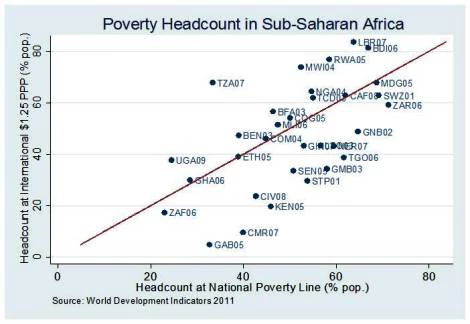 Today poverty data are available for almost all countries in the world1. Because a country’s success is measured by the number of people it lifts out of poverty, identifying best performers is a fair exercise only if poverty indicators are fully comparable. One indicator used is the share of the population whose consumption (or income) level is below a nationally defined poverty line or the US 1.25 dollar PPP per day. But even if policy makers and other stakeholders can count on readily available statistics, the poverty numbers should not be taken at face value.
Today poverty data are available for almost all countries in the world1. Because a country’s success is measured by the number of people it lifts out of poverty, identifying best performers is a fair exercise only if poverty indicators are fully comparable. One indicator used is the share of the population whose consumption (or income) level is below a nationally defined poverty line or the US 1.25 dollar PPP per day. But even if policy makers and other stakeholders can count on readily available statistics, the poverty numbers should not be taken at face value.
Data are useful if they give us a sense of reality
Poverty data are based on a set of arbitrary assumptions that may lead to erroneous conclusions. In the graph, Tanzania ranks among the poorest countries in Sub-Saharan Africa when poverty is defined by the US$1.25 per day threshold, but among the least poor when the national poverty line is the yardstick.
Click on the graph to see it bigger
Each of these indicators is constructed differently. For example, to update its national poverty line in 2007, had Tanzania used its official Consumer Price Index - as Uganda did – instead of a survey-based price index, its poverty headcount would have been 18 percent rather than 33 percent. To compute its poverty line, Uganda assumes that a person needs 3000 kilo calories per day, which is 40 percent higher than the threshold used in Angola or Mozambique. This mechanically leads to higher poverty rates in the first country, keeping everything else constant.
When it comes to the international $1.25 a day poverty headcount, countries measure consumption differently some including durables which others totally exclude2. Those differences arise from technical decisions that may be driven by data limitations but could also reflect political interference to influence the results.
The heart of the matter
Over the last two decades, most developing countries have launched household surveys to better understand households’ consumption patterns and measure poverty3. This quest for data suffers from the lack of a recent population census (e.g., Madagascar’s latest 2010 household survey’s sample is based on the 1993 census). Often questionnaires are imported from other contexts without specific context in mind, such as the large fraction of illiterate households who may have difficulties in responding to a lengthy and complex questionnaire (illiteracy rates are as high as 74 percent in Mali or 64 percent in Ethiopia). And if one questionnaire yields poor results, it is often changed substantially in the next survey, with no regard for comparability.
Assuming the collected data are reliable, we still have a problem because measuring poverty involves the construction of (1) a consumption aggregate that captures a household’s total consumption, and (2) a poverty line that is the consumption level below which a household is deemed poor.
To be meaningful, a consumption aggregate should include the major spending categories of each household. Yet, in Tanzania, it excludes important expenditure such as health, education and utilities. Some surveys include housing (Angola, Uganda); others don’t (Sudan). Related to the measurement of consumption is the adjustment for cost of living differences. Because prices vary across time and locations, consumption has to be normalized using a price index. Here, again practices differ with some countries using prices collected through the survey (unit values or community level prices) and others using national indices, based on prices collected through different surveys of rural and urban markets4. There is still no consistent methodology to measure consumption across countries and within countries over time.
The second calculation is to define the national poverty line. Again, the methodologies differ widely across countries. The kilo calorie threshold adequate for human functioning on which the food poverty line is anchored varies from 2100 in Angola to 2400 in Malawi and 3000 in Uganda. The reference group used to derive the consumption basket of the poor ranges from the bottom 28% of the population in Sierra Leone to 70% in Angola, while other countries like Malawi choose households in the middle of the consumption distribution. The international poverty lines makes this issue very simple, by just assuming that everyone in the country needs the same amount of money per capita to live on.
In short, there are no two countries in Sub-Saharan Africa whose poverty headcounts can be considered comparable and very few where the headcounts can even be considered comparable over time within the country5.
Africa’s poverty statistics tragedy calls for action
First, consumption and poverty measurement should be harmonized across countries. As with National Accounts, one single approach has to be defined, under the auspices of international institutions, to iron out technical differences6. This will make comparisons across countries more meaningful and at the same time help minimize political interferences because technical options would be pre-determined to a large extent.
Second, the frequency of data collection for poverty measurement should be increased. One should be able to distinguish between transitory and structural poverty. The financial situation of many households varies significantly from one year to the next. The 2010 household survey in Madagascar was rightly influenced by the unstable political conditions and indicated an increase of 9 percentage points in the poverty rate compared to 20057. Similarly, climatic conditions can shift poverty levels. Poverty has certainly temporarily risen in the Horn of Africa because of the major drought suffered by these countries. It is frequently argued that periodic surveys are impossible because of their costs (US$1-2 millions). But this figure represents such a marginal share of official aid toward developing countries that they could be funded easily.
Wouldn't it be more persuasively powerful to have reliable, frequent and comparable poverty statistics that properly capture the reality on the ground and would rightly inform policy makers on the impact of the full range of their poverty alleviation policies? Ending the statistical tragedy could go a long way to ending the human tragedy.
“The issue of poverty is not a statistical issue. It is a human issue.”
James Wolfensohn
------------------------------------------
Notes:
1. See for example, the World Development indicators, www.worldbank.org
2. This indicator also assumes no difference between rural and urban needs and the national CPI is always used as deflator without taking account regional variations.
3. For the layman, the concept of poverty is simple -- a household is poor if it does not have enough income to make ends meet. This simple idea could however not be applied in reality because income data are very difficult to collect in the developing world. For this reason, economists have developed an alternative approach based on consumption needs: a household who is able to fill its basic needs is therefore out of poverty. This approach is now well accepted worldwide.
4. Consumer Price indexes are usually urban while survey prices also include prices faced by the rural population which, in most countries in Sub-Saharan Africa, represents the majority.
5. This annex shows for few countries the various decisions made for the construction of the consumption aggregate and poverty line.
6. The SHIP initiative of the World Bank Chief Economist for the Africa region is one step towards the right direction.
7. The Government was not recognized by the International community and aid was temporally suspended by most donors.
Bonus file: Differences among african countries when measuring poverty (excel file)




Join the Conversation